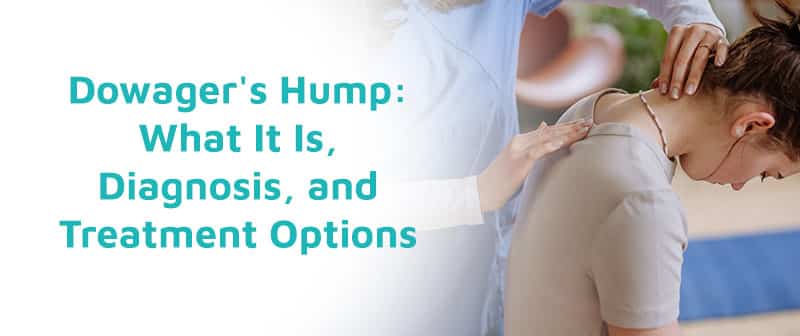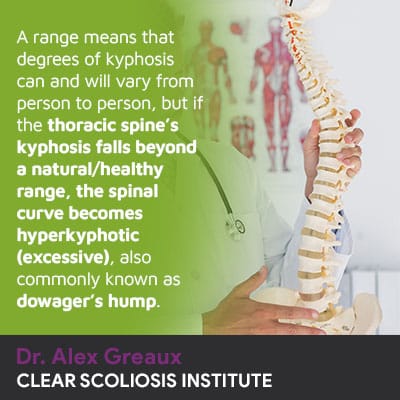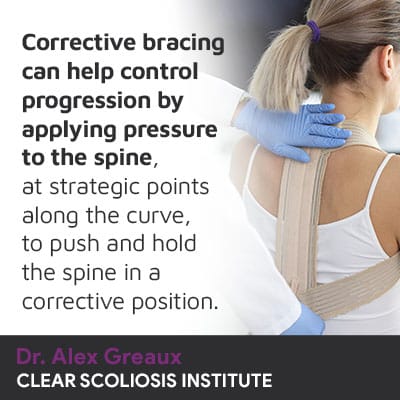
Each of the spine’s main sections has its own unique curvature type, and while these curvature types have a healthy range, when a curvature degree falls beyond a normal range, becoming excessive, problems can occur. Formerly known as dowager’s hump, hyperkyphosis involves the spine’s natural backward-bending curve becoming excessive, which can cause a roundback appearance and a number of other symptoms.
Dowager’s hump is used to reference a spinal condition that involves excessive kyphosis. Kyphosis references the spine’s natural backward-bending curve at the thoracic level; when a person’s level of kyphosis becomes excessive, this is hyperkyphosis and can cause a roundback appearance.
Discussing the spine’s natural and healthy curves is a good place to start before moving on to what happens when the spine’s healthy curves are replaced by bad curves.
When viewing a healthy spine from either side, it has an ‘S’ shape, but if viewed from the front and/or back, it looks straight; this is because the spine is naturally curved at each of its sections.
The spine is made up of sections that are comprised of vertebrae and intervertebral discs. These discs are actually quite important to the overall health and function of the spine.
They provide structure, enable flexible movement, and act as shock absorbers for the body. It's not just the healthy curves of the spine that are crucial, but also the health of the vertebrae and respective intervertebral discs that help keep it strong and functioning properly.
In order for the spine to function optimally, the spine needs to maintain its natural curves and alignment; however, there are a number of spinal conditions that involve a loss of the spine’s healthy curves.
The spine is divided into three main sections: the cervical spine (neck), the thoracic spine (middle/upper back), and the lumbar spine (lower back). Each part has a distinct spinal curve that either bends forward or backward.
The cervical and lumbar sections naturally form a lordotic curve, which bends forward and creates a 'C' shape. In contrast, the thoracic section has a kyphotic curve, which causes the spine to bend backward and form a backward 'C' shape.
While there is a natural range of lordosis and kyphosis, when that range falls beyond normal level, becoming excessive, this is when the curvature becomes problematic.
A healthy range of cervical lordosis falls within the 20-to-40 degree range, with lumbar lordosis falling within a range of between 40 and 60 degrees.
When it comes to the thoracic spine’s natural range of kyphosis, we’re also talking about a 20-to-40 degree range.

To diagnose a dowager's hump, it is necessary to identify the postural changes it causes and the various symptoms associated with it, such as localized back pain and/or radicular pain felt in different areas of the body. The diagnosis process generally includes a physical examination, a review of the patient's medical/family history, especially concerning spinal conditions, and observation of the patient's posture and gait.
Spinal misalignment, and any related postural asymmetries, are more visible when in a forward-bend position, which is why an Adam’s forward bend test is often part of reaching a hyperkyphosis diagnosis.
It is important to note that Dowager's hump is typically diagnosed in adults over the age of 40, especially in women, due to hormonal and bone-density changes associated with menopause that can weaken the spine. A diagnosis is usually confirmed through X-ray imaging and specific curvature-degree measurements, which show that the patient's kyphosis at the thoracic region of the spine is 50+ degrees.
Following a diagnosis of dowager’s hump, aka hyperkyphosis, the most important decision to be made is how to treat it moving forward; available treatment options will be shaped by experienced symptoms, condition severity, and type (cause).
Before exploring the different types and causes of hyperkyphosis, let’s address some of the condition’s common symptoms.
A clear indication of hyperkyphosis is the noticeable rounding forward of the upper back, including the shoulders. This condition is sometimes referred to as roundback due to its overt appearance.
In addition to postural changes, spinal conditions also have the potential to cause a number of effects felt throughout the body; remember, the brain and spine work in tandem to form the body’s central nervous system (CNS).
The central nervous system is a complex network that facilitates brain-body communication, so it is involved in the function of virtually every working system within the body.
When someone has hyperkyphosis, their upper back and shoulders round forward noticeably. This can cause a range of symptoms, which can vary depending on the individual's age, how severe their condition is, and how much their nerves are affected.
In addition to the noticeable rounding of the upper back, what other symptoms can hyperkyphosis cause? The effects of the condition can be different for each person, but one common symptom is radicular pain, which can cause tingling sensations anywhere along the affected nerve pathway and numbness in the legs and feet.
Maintaining good posture and gait takes more effort when the spine has an unnatural curve, which can cause fatigue. Changes to coordination, gait, and balance are also common due to the uneven forces of the condition. In more severe cases, untreated hyperkyphosis can even lead to bowel/bladder issues and lung impairment.
To effectively treat hyperkyphosis, it's crucial to identify and address the underlying cause of the condition. Treatment plans that focus on the root cause not only address symptoms, but also help achieve sustainable long-term results.
Similar to other spinal conditions, hyperkyphosis comes in different types, including postural, congenital, and Scheuermann's kyphosis. By understanding the type of hyperkyphosis, healthcare providers can tailor treatment options to the individual's specific needs.
Postural kyphosis is a commonly occurring form of kyphosis that isn't caused by an abnormality within the spine. Instead, it results from chronic poor posture that places uneven forces on the spine over time, leading to changes in the position of the vertebrae. One example of this is the modern spinal issue known as tech neck, where the cervical spine is strained due to being held in a downwards position for extended periods while looking down at devices like phones and computers.
This condition, officially known as forward head posture, increases the weight of the head on the cervical and upper thoracic spinal regions and can contribute to the development of a dowager's hump. It's important to note that identifying the underlying cause of postural kyphosis is crucial for effective treatment, as it can lead to long-term results.
In addition, certain lifestyle choices can also contribute to the development of postural kyphosis: carrying excess weight (extra pressure on the spinal joints), leading a sedentary lifestyle (contrary to the spine’s movement-based design), and repeatedly lifting heaving objects incorrectly (straining the spine and increasing risk of injury).
It is worth noting that postural kyphosis is a nonstructural form of kyphosis, which makes it easier to treat compared to other types. Identifying the underlying cause of this condition is important to achieve long-term results.
In many cases, lifestyle guidance (postural remodeling), condition-specific stretches/exercises, and a variety of physical therapies can restore the thoracic spine’s healthy range of kyphosis; structural forms are more complex to treat.
Cases of congenital kyphosis are structural in nature as it’s caused by a structural malformation within the spine that develops in utero.
Malformations can include a vertebral body being more triangular in shape, versus healthy rectangular-shaped vertebral bodies, making it difficult for the spine to form in a neutral and straight alignment, instead becoming excessively rounded.
Most misshapen vertebrae involve the front edges not developing properly, commonly forming into a wedge shape, and this causes affected vertebrae to shift forward, misaligning the spine.
While some cases of congenital kyphosis can be idiopathic (cause is unknown), most involve the malformation of vertebral bodies in the thoracic spine.
Treating congenital kyphosis is a complex process due to its structural nature and the unique challenges associated with treating young patients. Treatment plans must be tailored to the patient's age, and close monitoring of progression is crucial. Bracing may be necessary during the pre-skeletal maturity stage, but in some cases, surgery may be recommended.
Scheuermann's kyphosis is a spinal condition that develops gradually, with frequent peaks during periods of growth and development, making it most common in adolescents.
Again, as a structural condition, Scheuermann’s kyphosis involves a structural abnormality within the spine itself; no change in position can alter the unnatural spinal curve, as it can in nonstructural postural spinal conditions.
In a healthy spine, the vertebrae are rectangular in shape, which allows them to easily remain stacked on top of one another in a straight and neutral alignment, but in cases of Scheuermann’s kyphosis, one or more vertebrae have an abnormality, often involving their fronts not growing as fast as their backs, making them more triangular in shape.
When vertebrae are more triangular, than rectangular, in shape, they become wedged together and shift forward, causing the roundback appearance, commonly known as dowager’s hump.
Scheuermann's kyphosis is a progressive spinal condition characterized by an excessive thoracic kyphosis of 50+ degrees. It is important to note that if left untreated, the condition will worsen over time. This condition is typically diagnosed in adolescents during periods of growth and development.
Treatment plans for Scheuermann’s kyphosis are crafted around key patient/condition variables: patient age and overall health, condition severity, and experienced symptoms.
While each case is unique, treatment plans that integrate multiple condition-specific forms of treatment such as chiropractic are, a variety of physical therapy approaches, corrective bracing, when necessary, and rehabilitation to further stabilize the spine can impact the condition on every level.
Structurally, chiropractic care can impact the condition by using a series of chiropractic techniques and manual adjustments to adjust the position of the curve’s most-tilted vertebrae, at its apex, back into alignment with the rest of the spine.
Physical therapy is key to helping patients increase their core strength: a facet of treatment because it’s not just the spine that’s in charge of maintaining its natural curves/alignment, but also its surrounding muscles.
Increasing core strength can mean the spine is being optimally supported.

Bracing is used as a facet of treatment for a variety of structural spinal conditions, dowager’s hump included; generally speaking, bracing is most effective on growing patients who have yet to reach skeletal maturity.
While each case is unique, in ideal circumstances, a dowager’s hump correction brace should be worn at the onset of puberty, throughout growth, and until skeletal maturity is reached.
With different types of corrective braces to choose from, a patient’s treatment provider will select one that’s best suited to the specifics of a patient and their condition: patient age, condition type, and severity.
Corrective bracing can be used to control the progression of Scheuermann's kyphosis by applying pressure to strategic points along the curve of the spine, which can help push and hold the spine in a corrective position. It is important to note that bracing is most effective on growing spines and is not a typical form of treatment for adults, unless the goal is to manage pain and increase spinal stability rather than to reduce curvature or counteract progression.
While the term dowager's hump is no longer commonly used, the condition it describes, hyperkyphosis, remains prevalent. Hyperkyphosis is characterized by an excessive curve in the thoracic spine, causing the upper back and shoulders to pitch forward.
There are different types of dowager's humps, including postural, congenital, and Scheuermann's kyphosis. Symptoms can vary but typically include forward-rounding of the upper back, neck, shoulder, and back pain (more common in adults), and in some cases, radicular pain, numbness, or tingling in different parts of the body due to nerve involvement.
As a CLEAR-certified scoliosis chiropractor, I have treated many patients with hyperkyphosis and have seen the benefits of proactive treatment. A customized approach that combines chiropractic care, specific exercises and physical therapy, corrective bracing, and rehabilitation can help realign the spine and increase core strength, providing optimal support for the surrounding muscles. Regardless of age or severity, proactive treatment can have a positive impact on overall quality of life.

CLEAR provides a unique and innovative way of understanding scoliosis. Sign up to receive facts and information you won’t find anywhere else.
